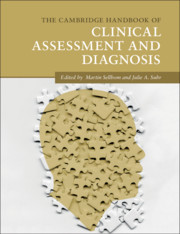Book contents
- The Cambridge Handbook of Clinical Assessment and Diagnosis
- The Cambridge Handbook of Clinical Assessment and Diagnosis
- Copyright page
- Contents
- Figures
- Tables
- Contributors
- Acknowledgments
- 1 Introduction to the Handbook of Clinical Assessment and Diagnosis
- Part I General Issues in Clinical Assessment and Diagnosis
- Part II Specific Clinical Assessment Methods
- Part III Assessment and Diagnosis of Specific Mental Disorders
- 21 Assessment of Childhood Neurodevelopmental Disorders
- 22 Assessment of Childhood Disruptive Behavior Disorders and Attention-Deficit/Hyperactivity Disorder
- 23 Assessment of Depressive Disorders and Suicidality
- 24 Assessment of Anxiety Disorders and Obsessive-Compulsive Disorder
- 25 Assessment of Trauma- and Stressor-Related Disorders
- 26 Assessment of People with Psychotic and Bipolar Disorders
- 27 Assessment of Eating Disorders
- 28 Assessment of Substance Use Disorders
- 29 Assessment of Personality Disorder
- 30 Neuropsychological Assessment of Dementia
- 31 Assessment of Traumatic Brain Injuries
- Part IV Clinical Assessment in Specific Settings
- Index
- References
27 - Assessment of Eating Disorders
from Part III - Assessment and Diagnosis of Specific Mental Disorders
Published online by Cambridge University Press: 06 December 2019
- The Cambridge Handbook of Clinical Assessment and Diagnosis
- The Cambridge Handbook of Clinical Assessment and Diagnosis
- Copyright page
- Contents
- Figures
- Tables
- Contributors
- Acknowledgments
- 1 Introduction to the Handbook of Clinical Assessment and Diagnosis
- Part I General Issues in Clinical Assessment and Diagnosis
- Part II Specific Clinical Assessment Methods
- Part III Assessment and Diagnosis of Specific Mental Disorders
- 21 Assessment of Childhood Neurodevelopmental Disorders
- 22 Assessment of Childhood Disruptive Behavior Disorders and Attention-Deficit/Hyperactivity Disorder
- 23 Assessment of Depressive Disorders and Suicidality
- 24 Assessment of Anxiety Disorders and Obsessive-Compulsive Disorder
- 25 Assessment of Trauma- and Stressor-Related Disorders
- 26 Assessment of People with Psychotic and Bipolar Disorders
- 27 Assessment of Eating Disorders
- 28 Assessment of Substance Use Disorders
- 29 Assessment of Personality Disorder
- 30 Neuropsychological Assessment of Dementia
- 31 Assessment of Traumatic Brain Injuries
- Part IV Clinical Assessment in Specific Settings
- Index
- References
Summary
This chapter focuses on the assessment of eating disorders for the purpose of deciding on appropriate treatment pathways. Given the ambivalence inherent in eating disorders, in order to increase the likelihood of accurate and informative reporting as well as the likelihood that the patient will move to treatment, the aims of assessment should include (1) the initiation and establishment of rapport and therapeutic alliance; (2) the development of a collaborative understanding of the behaviors and cognitions that typify the eating disorder, where psychoeducational materials can be used to validate the patterns and cycles described; (3) the development of an understanding of ambivalence and obstacles for change; and (4) a review of any comorbidity that may require resolution before treatment can commence for the eating disorder. Each of these aims are explored in the chapter, along with specific suggestions for ways to achieve these.
- Type
- Chapter
- Information
- The Cambridge Handbook of Clinical Assessment and Diagnosis , pp. 371 - 384Publisher: Cambridge University PressPrint publication year: 2019
References
- 1
- Cited by



